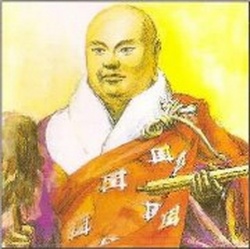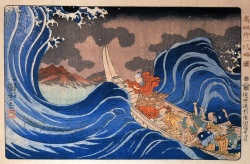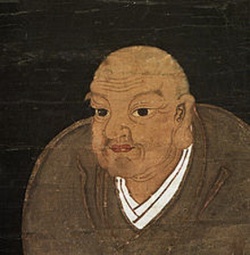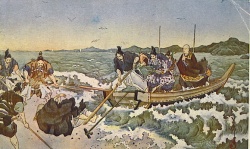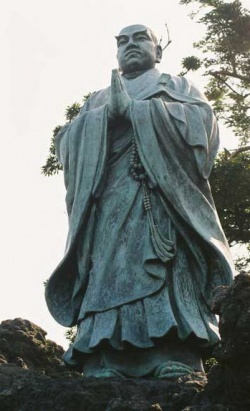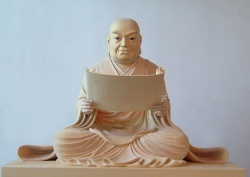Nichiren (1222–1282)
The founder of the Buddhist tradition, that is based on the Lotus Sutra and urges chanting the phrase Nam-myoho-renge-kyo as a daily practice. Nichiren revealed that Nam-myoho-renge-kyo (Myoho-renge-kyo being the title of the Lotus Sutra) represents the essence of the Lotus's teaching. He embodied it in a mandala called the Gohonzon and taught that chanting that phrase with faith in the Gohonzon is the practice that enables people in the present age, the Latter Day of the Law, to attain Buddhahood.
Nichiren was born on the sixteenth day of the second month, 1222, in Tojo Village of Awa Province, Japan. His father was Mikuni no Taifu, and his mother, Umegiku-nyo. His childhood name was Zennichi-maro (also called Zennichi-maru). In 1233 he entered a nearby temple of the Tendai school called Seicho-ji, where he studied both Buddhist and sec-ular teachings under the senior priest Dozen-bo. According to Nichiren's Letter to the Priests of Seicho-ji, written in 1276, Zennichi-maro prayed before a statue of Bodhisattva Space Treasury at Seicho-ji to become the wisest person in Japan. As a result, the letter says, he obtained "a great jewel," or a jewel of wisdom that later enabled him to grasp the essence of all the sutras.
In 1237 he was formally ordained and took the name Zesho-boRen-cho. Soon after, he left for Kamakura, the seat of the shogunate, to further his studies. Thereafter he returned briefly to Seicho-ji and then set out again for such major centers of Buddhist learning as Mount Hiei, Mount Koya, Onjo-ji temple, and other temples in the Kyoto and Nara areas. During these years he studied all of the available sutras and commentaries, as well as the teachings of the different Buddhist schools. He became firmly convinced that the highest of Shakyamuni's teachings is the Lotus Sutra, and that the great pure Law that leads directly to enlightenment in the Latter Day of the Law is implicit in that sutra. He was also convinced that his was the mission of Bodhisattva Superior Practices, who, according to the Lotus Sutra, was entrusted with the task of propagating that Law in the Latter Day. He resolved to declare the sutra's supremacy and point out the misconceptions of the prevailing Buddhist schools, though he knew that the Lotus Sutra predicts its votary will experience severe persecutions.
In 1253 he returned to Seicho-ji. There at noon on the twenty-eighth day of the fourth month, he preached to an assembly of priests and villagers who had gathered to hear the results of his studies. In that first sermon, he declared that the Lotus Sutra is the true teaching of Shakyamuni Buddha, and that its essence, Nam-myoho-renge-kyo, is the very teaching in the Latter Day of the Law that enables all people to attain Buddhahood in this lifetime. On this occasion he renamed himself Nichiren (Sun Lotus). He also severely criticized the widespread Nembutsu (or Pure Land) doctrine as one that drives people into the hell of incessant suffering. Tojo Kagenobu, the steward of the area and an ardent Nembutsu believer, became furious on hearing this. He ordered his warriors to seize Nichiren, who narrowly managed to escape with the help of the priests, Joken-bo and Gijo-bo, who were his seniors when they were desciples together at Seicho-ji. After converting his parents and giving the Buddhist name Myonichi (Wonderful Sun) to his father and [[Myoren (Wonderful Lotus) to his mother, he headed for Kamakura to launch his efforts to spread his teaching. In Kamakura he lived in a dwelling at a place called Matsubagayatsu in Nagoe. He devoted the next several years primarily to converting individuals, eventually gaining a number of followers. Among the first priests to become his disciples were Nissho and Nichiro. Laypersons who converted were mostly samurai, including Toki Jonin, ShijoKingo, Kudo Yoshitaka, and the Ikegami brothers.
Japan at that time was experiencing a succession of unusually severe storms, earthquakes, drought, famine, epidemics, and other disasters. Corpses littered the streets. Government relief measures and the prayers offered by shrines and temples were no help. An earthquake that struck Kamakura in the eighth month of 1257 destroyed the greater part of the city. Nichiren, determined to clarify a solution to these calamities based on Buddhist principles, went to Jisso-ji temple in Suruga Province to do research in its sutra library. During his stay there, Nikko, then a boy of thirteen studying at the nearby Shijuku-in temple, became Nichiren's disciple. He would later become his successor. On the sixteenth day of the seventh month, 1260, Nichiren submitted a treatise titled On Establishing the Correct Teaching for the Peace of the Land to Hojo Tokiyori, the retired regent who was nevertheless the most influential man in the Kamakura shogunate. In that work, he attributed the disasters ravaging the country to slander of the correct teaching and belief in false teachings. In particular, he criticized the dominant Nembutsu school. Of the three calamities and seven disasters described in the sutras, he predicted that the two disasters that had yet to occur—internal strife and foreign invasion—would befall the nation without fail if it persisted in supporting misleading schools. He urged that the one vehicle teaching of the Lotus Sutra be embraced immediately. The submission of On Establishing the Correct Teaching is regarded as the first of his several remonstrations with Japan's rulers.
There was no official response to this document, but a crowd of Nembutsu believers, incited by priests and high government officials, attacked Nichiren's dwelling on the night of the twenty-seventh day of the eighth month. He narrowly escaped with a few disciples and stayed briefly with Toki Jonin in Shimosa Province. His sense of mission, however, would not allow him to remain there long. The next spring Nichiren returned to Kamakura. This time leaders of the Nembutsu priests accused him of defamation, and the shogunate, without trial or further investigation, sentenced him to exile in Itoon the Izu Peninsula.The boatmen charged with his transport did not take him to Ito, but abandoned him on a beach called Kawana to the mercy of the local inhabitants, many of whom were Nembutsu believers and were in any case hostile to exiles. Nichiren was sheltered for a time by a fisherman named Funamori Yasaburoand his wife. Later Nichiren won the favor of the steward of Ito when he successfully prayed for the steward's recovery from a serious illness. Nichiren was pardoned and returned to Kamakura in the second month of 1263. Concerned about his aged mother (his father had died in 1258), Nichiren returned to his native Awa in the autumn of 1264. He found his mother critically ill. He prayed for her, and she recovered and lived four more years. He stayed in Awa for awhile to conduct propagation activities.
On the eleventh day of the eleventh month, while still in Awa, he set out with a group of followers to visit Kudo Yoshitaka, one of his samurai believers, at Yoshitaka's invitation. En route, Nichiren and his party were ambushed by TojoKagenobu and his men at a place called Komatsubara. Nichiren's disciple Kyonin-bo was killed, and Kudo Yoshitaka, who came rushing to the scene, died of wounds he suffered in the fight. Nichiren sustained a sword cut on his forehead and a broken hand. This incident is called the Komatsubara Persecution.
During the next three years or so, Nichiren devoted himself to propagation in Awa, Kazusa, Shimosa, and Hitachi provinces, and then returned to Kamakura. Early in 1268, an official letter from the Mongol Empire arrived in Japan with a demand that Japan acknowledge fealty to it or prepare to be invaded. The arrival of the letter from the Mongols substantiated Nichiren's earlier prophecy of foreign invasion.In the fourth month Nichiren sent his newly written rationale for having completed the treatise On Establishing the Correct Teaching to a government official named Hogan, pointing out that the prediction made in the treatise was beginning to come true and urging the shogunate to heed his admonitions. On the eleventh day of the tenth month, he sent eleven letters to influential political and religious leaders, including the regent Hojo Tokimune, urging them to abandon their faith in erroneous teachings and demanding the opportunity for a public religious debate. There was no response.
In 1271 the country was troubled by persistent drought, and the shogunate ordered Ryokan of Gokuraku-ji temple to pray for rain. Hearing of this, Nichiren sent Ryokan a written challenge, offering to become his disciple if Ryokan succeeded; on the other hand, if Ryokan failed, he should become Nichiren's disciple. Ryokan readily agreed, but despite his prayers and those of hundreds of attendant priests, no rain fell. Far from keeping his promise, he vindictively began to spread false rumors about Nichiren, using his influence among the wives and widows of shogunate officials. On the tenth day of the ninth month, Nichiren was summoned to court and interrogated by Hei no Saemon, the deputy chief of the Office of Military and Police Affairs (the chief being the regent himself). He reemphasized the errors of the True Word (Shigon), Zen, and Nembutsu schools and repeated his prediction that the country would face ruin if it continued to reject the correct teaching.
On the evening of the twelfth day of the ninth month, Hei no Saemon, with a large group of his soldiers, attacked and arrested Nichiren. As he later wrote, Nichiren said to Hei no Saemon at the time: "Nichiren is the pillar and beam of Japan. Doing away with me is toppling the pillar of Japan!" (579). Hei no Saemon then maneuvered to have Nichiren beheaded and had him taken late that night to the execution grounds at Tatsunokuchi. Just as the executioner had raised his sword to strike, a brilliant object shot across the sky, illuminating everyone like bright moonlight. Nichiren wrote later: "The executioner fell on his face, his eyes blinded. The soldiers were filled with panic" (767). In the end, they abandoned the execution. Nichiren wrote about this incident, called the Tatsunokuchi Persecution, in The Opening of the Eyes: "On the twelfth day of the ninth month of last year [1271], between the hours of the rat and the ox [11:00 P.M. to 3:00 A.M.], this person named Nichiren was beheaded. It is his soul that has come to this island of Sado and, in the second month of the following year, snowbound, is writing this to send to his close disciples" (269). Nichikan (1665-1726), the twenty-sixth chief priest of Taiseki-ji temple, interpreted this passage to mean that the ordinary person Nichiren died at Tatsunokuchi, but the Buddha of the Latter Day of the Law Nichiren survived. This is called "casting off the transient [[[Wikipedia:status|status]]] and revealing the true (identity) ( Jpn hosshaku-kem-pon )." After this, Nichiren began to inscribe the object of devotion known as the Gohonzon.
On the tenth day of the tenth month, after an almost one-month stay in Echi in Sagami Province, Nichiren left under escort for Sado Island, his designated place of exile, and arrived at Tsukahara on Sado on the first day of the eleventh month. There he was assigned as his dwelling a dilapidated hut in a graveyard, exposed to the wind and snow. On the sixteenth day of the first month in the following year, several hundred priests from Sado and the mainland came to confront him in religious debate. In what is known as the Tsukahara Debate, Nichiren refuted those priests and won converts. In the second month of that year, Nichiren's prediction of internal strife came true when HojoTokisuke, an elder half brother of Regent HojoTokimune, made an abortive attempt to seize power. In the fourth month Nichiren was transferred from Tsukahara to the more comfortable residence of the lay priest Ichinosawa. While on Sado he wrote many of his most important works, including The Opening of the Eyes, The Object of Devotion for Observing the Mind, The Heritage of the Ultimate Law of Life, The True Aspect of All Phenomena, The Entity of the Mystic Law, On the Buddha's Prophecy, and On Practicing the Buddha's Teachings.
In the second month of 1274, the shogunate issued a pardon for Nichiren, and he returned to Kamakura the next month. On the eighth day of the fourth month, Hei no Saemon summoned Nichiren and, in a deferential manner, asked his opinion regarding the impending Mongol invasion. Nichiren said that it would occur within the year and reiterated that this calamity was the result of slandering the correct teaching. On this occasion the shogunate offered to build him a large temple and establish him on an equal footing with all the other Buddhist schools, but Nichiren refused. He instead again refuted the errors of the shogunate.
The shogunate continued its support of the True Word and other schools. Convinced that he had done all he could to warn the nation's leaders of their religious errors and of what would ensue as a result, Nichiren now turned his efforts to ensuring the correct transmission of his teachings to posterity. In keeping with an old maxim that a worthy man who warns his sovereign three times and still is not heeded should withdraw to a mountain forest, he left Kamakura on the twelfth day of the fifth month, and went to take up residence at the foot of Mount Minobu in Kai Province. There he gave lectures on the Lotus Sutra and devoted himself to training his disciples. He also continued to write, producing such important documents as One Taking the Essence of the Lotus Sutra, The Selection of the Time, and On Repaying Debts of Gratitude.
In the tenth month of 1274, the Mongols launched a massive attack against the southern Japanese islands of Iki and Tsushima and advanced to Kyushu. Japanese losses were staggering, but one night when the Mongol forces returned to their battleships, an unexpected storm arose and heavily damaged the Mongol fleet, which then withdrew. In the fourth month of the next year, however, the Mongols sent an envoy relaying a threat of another invasion if the Japanese government did not acknowledge fealty to their empire. During this period, Nichiren was busy at Minobu writing letters, training his disciples, and lecturing on the Lotus Sutra. Nikko assumed active leadership in disseminating Nichiren's teachings, concentrating his efforts in Kai, Izu, and Suruga provinces. These activities led to an increase in converts among both the priesthood and laity, and eventually to more oppression. In Atsuhara Village of the Fuji area, in particular, believers were repeatedly threatened and harassed, and some were finally executed. In what later became known as the Atsuhara Persecution, twenty believers, all farmers, were arrested on false charges on the twenty-first day of the ninth month, 1279. Though tortured to force them to recant their beliefs, not one of the twenty farmers yielded. Three of them were beheaded on the fifteenth day of the tenth month (another account, the eighth day of the fourth month, 1280). Nichiren, seeing that his followers now had the strength to uphold their faith even at the cost of their lives, determined that the time had come to fulfill the ultimate purpose of his life. On the twelfth day of the tenth month, 1279, he inscribed the object of devotion (known as the Dai-Gohonzon) and dedicated it for the attainment of Buddhahood by all humanity.
Subsequently, his health began to fail. Sensing that death was near, Nichiren designated Nikkoas his successor in a transfer document dated the ninth month of 1282. On the eighth day of the ninth month, he left Minobu at the urging of his followers to visit a hot spring in Hitachi. When he reached the residence of Ikegami Munenaka at Ikegami in Musashi Province, he realized that his death was imminent. There he lectured for his followers on On Establishing the Correct Teaching. On the eighth day of the tenth month, he named six senior priests and entrusted them with the responsibility for propagation after his death. Early on the morning of the thirteenth day of the tenth month, he appointed Nikko as the chief priest of Kuon-ji temple in Minobu, directing all believers to follow him. He died that morning, in the company of his disciples, both priests and laity. His lay followers conducted his funeral.
